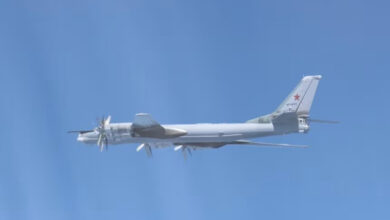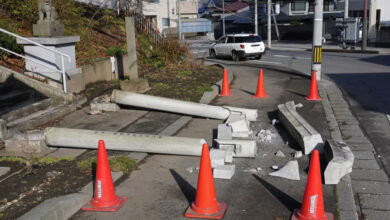Natori, Japan – Bundled up against the wind, Junpei Endo gets off his bicycle, sets it on its kickstand and ponders the dusty mementos he has collected in its wire basket. There is a stained and torn photo album. A few magazines. An old Pentax SLR camera. The kind that still uses film.
Endo dusts off the lens. He breaks into a smile for just a moment.
"It was my father's camera," he says. "He loved this camera."
Nearly three weeks after a tsunami devastated communities along Japan's coast, the neighborhood around "Hiyori Yama" — Weather Hill — is beginning to show signs of life.
Endo grew up in the big green house down the street from the hill. He remembers the fireworks in summer. Going up the hill to feel the breeze, to laugh and play. The Sunday bazaar in the parking lot by the bridge, where fishermen sold flounder and mackerel fresh from the sea.
He left town three years ago, when he was 28, to work near Tokyo.
After hearing about the tsunami, he drove back as fast as the roads would allow. His mother told him what had happened.
His father, a retired newspaperman, was home alone that afternoon. "He probably didn't have a chance," Endo says, tears welling up as he tugs at his dirty black ski cap. "He died alone."
___
Thirty-five steps to the top, Weather Hill was named by local fishermen. It's a common name in coastal villages. The fishermen would climb the man-made hump of dirt and grass and decide whether it was safe to fish. They would look out at the waves, a few hundred meters away, and check the weather coming in.
Today the hill offers an unforgettable view of the vastness of the calamity that began with a huge offshore earthquake at 2:46 p.m. on 11 March, followed by the tsunami.
Survivors come to pick through the remains of their homes at the foot of the hill. Others, some with binoculars or video cameras, come from out of town to see the destruction firsthand — and let the awe of it all sink in.
"I was born right down there," says 77-year-old Chikuko Otomo, pointing across an expanse of sand, sludge and twisted metal to a bare, concrete foundation just visible above the rubble. "I grew up right here. It was a good place. It bustled. I moved up to the city when I got married, but I still came back often to see my family and my friends. I had so many friends here."
She wanders into a small park next to the hill, where kids would play on a rusty swing set and a slide, across the street from the Sasanao fish-patty factory.
The swings and slide are nowhere to be seen. There is a pink tea pot sticking out of the sludge. A blue rubber boot filled with sand. A radiator. A few fallen trees and streetlights. A half-buried umbrella.
Otomo laughs when she recognizes a waist-high ceramic black bear — it was the drinking fountain.
She stops at a twisted metal signpost that reads: "Laughter is what keeps families together."
"It's gone," she says, more to herself than anyone else. "It's just all gone."
Now helicopters buzz overhead, and US military planes cross the sky delivering emergency supplies. Japanese soldiers in dark green camouflage uniforms and white surgical masks pull bodies out of shattered homes a few blocks away.
Block after block is obliterated. All that is left is a concrete labyrinth of foundations of homes that once crowded the horizon. Cars are crumpled and flipped over, far from any road, covered in a spider web of fish nets. A few skeletal buildings jut up, their first floors bashed to bits, but their second floors intact, sometimes almost untouched.
Heavy equipment operators stack metal and wood debris in tall piles in the lot down by the bridge. The one where they used to hold the Sunday bazaar.
___
The neighborhood around Weather Hill was a nondescript slice of middle-class suburbia.
About 8000 people lived in this part of Natori city. They were office workers, homemakers, nurses, carpenters, supervisors at the big Sapporo brewery and the Nikon factory. And, of course, the fishermen.
The houses were mostly two-story, cookie-cutter jobs, one right on top of the next. They were built up fast and affordable and not really meant to last.
The hill was just high enough to see over their tops. From below, you couldn't see the water. You almost wouldn't know it was out there.
A little Shinto shrine stood on top of the hill under a scraggly pine tree. In 1954, a 15-foot-high stone memorial bearing the names of those from Natori killed in World War II was erected.
The cenotaph still stands. But the shrine is gone. In its place, a shattered, tiled roof sits atop a pile of timber that was the upper story of someone's home. Personal effects — photos, souvenir dolls, comic books, playing cards — are scattered around it. A mud-covered futon mattress hangs in the branches of the pine tree.
"This is very strange," says Etsuo Matsumoto, a real estate agent whose house was a street down from Endo's, as he reconnoiters the round, flat patch of ground on top of the Hill. "I guess this must have been swept up here when the tsunami came in. I don't recognize it. It must have washed up from down there around the fish market and came to rest here."
An old acquaintance comes up the steps. They talk for a few minutes.
"How many people survived?" his friend asks.
"I don't know," Matsumoto says. "So many people are missing. So many."
___
Virtually every Japanese neighborhood has a Buddhist temple. The one near Weather Hill is called Tozenji. After checking out their losses, survivors seem to find their way to it.
Its gently sloping roof stands out above the ruins. One wall is gone, reduced to a stack of wood, smudged sutra books, idols and garbage. Another has a hole big enough to drive a truck through. Only two sound walls keep the structure from collapsing completely.
The wind from the sea blows at a jumble of paper on the floor, which has been stripped of its tatami mats. It rattles a golden chandelier — a symbol of nirvana — that hangs from the ceiling.
Kazushi Obata makes his way through the temple's cemetery in search of his family grave. The black marble stones are all toppled, many broken in half. A few bodhisattva statues stand by the cemetery gate: Jizo, the protector of children. Kannon, the goddess of mercy.
He couldn't stay long. His retired father, who lived three blocks from the hill, had been identified the night before, his body found three kilometers inland.
Obata, a worker for the electricity company in nearby Sendai city, had to start thinking about the funeral. His mother is still missing. "We hope they will find her near where father was," Obata says.
Shoryu Sato, a priest from another temple farther inland, arrives in black robes and black sneakers, carrying a wooden staff and prayer beads. He asks if anyone knows the whereabouts of the abbot, Toshiaki Miyake, an old friend.
Miyake, a jovial octogenarian, is dead. His assistant priest may have survived, but no one really knows.
Sato mulls around for a few minutes, clasps his hands in prayer and prepares to leave.
"We think we can survive anywhere," he says. "We've had earthquakes and tsunamis here before. But humans are arrogant. We forget that we are not invincible. We forget that life is fleeting and nature is more powerful than we are. Then something like this reminds us otherwise."




